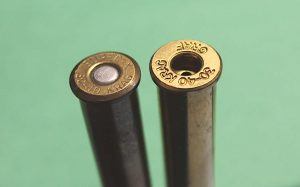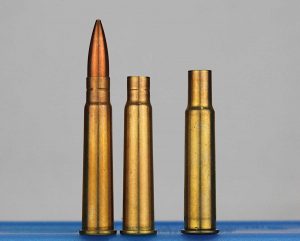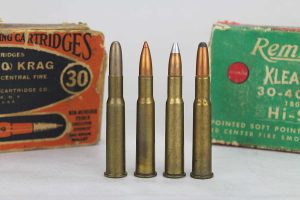By Art Merrill |Contributing Editor

The .30-40 Krag case rim has a bevel that may be less pronounced on some makers’ brass.
Among America’s oldest .30 calibers, the 30-40 Krag is unusual in being a hanger-on that, for any practical reason, should be long gone.
The .30-06 of 1906 – the souped-up .30-03 of 1903 – is likely still the single most popular .30 caliber among American hunters after 113 years. The .30-30 (1895) remains with us because of the continued popularity of its natural habitat, the lever action rifle. It’s also remarkably forgiving to the handloader, the .30-30’s performance for a great deal of hunting and shooting is in the “Good Enough” category, and it’s still a go-to where long range and excessively loud reports and recoil of bigger cartridges are not desirable.
Performance wise, the .30-40 Krag (1892) doesn’t do anything that the .30-06 can’t do better. For decades now, factory loadings have been universally limited to 180 grain bullets, which leave the muzzle at considerably lesser velocity than from the .30-06. Slightly shorter in overall length and with a lot of neck, the Krag case has less room for powder while still requiring the same action length as the .30-06. And no major maker has made a serious run of Krag-chambered rifles since probably WWI, when the .30-06 eclipsed the Krag cartridge.
Still, the 30-40 Krag never completely went away, with factory loadings, though limited to a single bullet weight, never entirely disappearing. Part of the reason we can probably attribute to economics. Made obsolete by the .30-06 and Springfield rifles, after WWI milsurp Krags became available to shooters, hunters and gunsmiths for what we think of today as pocket change.
We can reasonably point to those milsurp rifles as the most significant reason for the cartridge’s longevity, and a lot of those Krags, both original and sporterized hunters, are still around today, with sporters often priced low enough to prompt curious and nostalgic shooters to impulsively reach for their wallets.
Another likely reason is that the Krag is not a finicky cartridge for the handloader. Still another is that, especially with heavy round nose (RN) bullets at reasonable hunting distance, the .30-40 Krag always has been and remains a reliable big game getter.
Lugs & Ribs
Adopted in 1892, though not actually issued until four years later, the American Krag-Jorgensen rifle predates the 1898 Mauser, when inventors were still working out bolt action rifle design. The most obvious feature of the Krag-Jorgensen is the magazine box protruding from the right side. Flip open the gate, drop cartridges in, close the gate and you’re ready to go. For a repeating combat rifle, there was nothing faster or, even today, less complicated.
The Krag also had a reputation for smooth feeding. The American Krag’s weak point (in retrospect, of course) is its single locking lug, necessitating keeping max pressures down to 40,000cup (SAAMI) or 44,000 – 47,100psi. On the .30-40 Krag rifle, the guide rib on the right side of the bolt turns down in front of the receiver bridge, but does not touch the bridge.

You can form .30-40 Krag (R) from 303 British (L) by running the Brit through the Krag full length resizing die (center). The shoulder may not move back but it will still chamber and finish forming upon firing.
The official Description and Rules for the Management of the U.S. Magazine Rifle, Model 1898, and Magazine Carbine, Model 1899 states, “The locking lug will sustain any powder pressure liable to occur, but if worn by usage or upset by excessive pressures, the rear end of the guide rib will bear on the locking shoulder of the receiver, permitting the continued use of the arm with safety.” If this happens, the bolt handle turned down into its slot behind the receiver bridge now assumes the duty of backup safety.
It is quite possible that these backup safety designs saved a face or fingers. According to Ludwig Olsen (American Rifleman Dope Bag, December 1957) some American .30-40 Krag rifle bolts were manufactured unduly hard and eventually suffered cracking at the single locking lug, but he had never seen the problem appear on the Norwegian or Danish Krag-Jorgensens. On the latter Krags, which the Norwegians and Danes chambered in 6.5x55mm Swedish, the rear of the guide rib is designed to contact the receiver bridge. This means the foreign versions essentially have two locking lugs, though the arrangement is asymmetrical.
The Americans carried the .30-40 Krag’s non-bearing bolt guide rib over into the M1903 Springfield rifle, and for the same reason, even though the Springfield has two front locking lugs: as backup in case of the locking lugs failing. Utilizing the bolt handle as further safety backup also carried forward from the Krag into the M1917 “Enfield” rifle.
Heavy bullets
The .30-40 Krag (aka 30 US Government, 30 USG, 30 US Army, 30 USA and occasionally .30-40 Winchester) started life launching a 220-grain bullet at 2,000 fps with a loading of black powder, but smokeless powder quickly supplanted black when it became available a few years later, which upped speed another 200 fps. The most popular Krag loading has long been with 180-grain spitzer bullets; reloading manuals show jacketed bullet velocities running from 1,730 to 2,408 fps. Bullets of 200 and 220 grains are in the 1,800 fps neighborhood.
Despite the 180 grain factory loading, the long throat in military Krag barrels wrings best precision from longer, RN bullets. Perhaps the lone factory choice is due to a perception that hunters wanted the slight velocity gain and ballistic improvement of lighter modern spitzers over “old school” 220-grain RN bullets. Or it may be that most commercial .30-40 Krag chambers had shorter throats.
If you want to follow suit, every major bullet maker has a 180-grain .30 caliber spitzer type hunting bullet, way too many to list here – go to your favorite bullet maker’s website and pick one out. There isn’t much ballistic advantage to spitzer bullets among the heavyweights for the Krag, as starting velocities are already comparatively low and the Krag isn’t going to reach out like a magnum; therefore, the 200- and 220-grain round nose (RN) bullet is a good choice for big game at normal-to-short hunting distance.

(L-R) Original military 220-gr cupronickel bulleted cartridge headstamped, “RA 17”; United States Cartridge Co. hollow point under a copper tip, c. 1920s; Western Silver Tip and Remington Core-Lokt c. 1950s-60s. The latter three are 180-gr. bullets.
Hornady makes a 220 in their Interlock design, as does Sierra in their Pro-Hunter line, both at reasonable cost that will allow plenty of affordable load development. Sierra also has a 200-grain RN soft point. Nosler offers a 220-grain RN, and a compromise half-spitzer/half RN “semi-spitzer,” as well.
Standard twist rate for the .30-40 Krag is 1:10. If shooting a milsurp Krag with original barrel, slugging the bore is a good idea as manufacture apparently ran anywhere from .307 to .310 inch. Cast lead bullets will likely improve precision in oversize bores.
Handloading guru Ken Waters felt the best cast bullets for the .30-40 Krag are the Lyman gas check designs thrown by moulds 311467 and 311466, due to their short noses, long shanks and plenty of lube grooves. If cast hard enough, he wrote, they can be driven close to the original 2,000 fps Krag velocity.
Waters reported 1.5 MOA with Lyman’s 165-gr. bullet from mould 311291 driven at 1,790 fps with 22 grains of IMR 4198. His most accurate cast bullet load was the 165-gr bullet from Lyman mould 311413 at a leisurely 1,398 fps using 14.5 grains of IMR 4227 magnum pistol powder. If you don’t cast, Oregon Trail https://www.oregontrailbullet.com/ offers a 200-grain .309 inch gas checked hard cast bullet suitable for the Krag.
We can shoot lighter bullets, of course, but expecting precision from 110-150 grain bullets in long-throated original milsurp barrels may be a bit overly optimistic, as lighter, shorter bullets must make quite a jump from the case to reach the rifling, which is not conducive to best accuracy.
Brass again
We can form .30-40 Krag from .303 British brass by running it into a .30-40 Krag full length resizing die, but the necks will be somewhat short. Also, there’s no reason to go this route; though Krag brass availability was off-and-on for the past decade or so, it seems to be on the comeback, at least for now. Captech brand goes for about $30/50, Hornady has it at around $40/50, and I bought my most recent batch from Graf & Sons (with their headstamp) two years ago for $43/50. Winchester and Remington appear to have discontinued offering the brass.
Note the edge of the Krag case rim has a bevel; the bevel is more pronounced on some brands of brass than others. Many attribute the Krag action’s smoothness to this bevel; whether it is true may be worthy of your own experimenting. Among shell holders, Hornady #11, Lee #5, Lyman #7, RCBS #7 and Redding #8 are the proper ones, but shell holders intended for 303 British or 44 Magnum may also work, as there is typically some variance between different manufacturers of brass and shell holders.
Not finicky

220-grain RN bullets like the Sierra are a natural in the Krag for hunting big game at normal to short distances. PHOTO COURTESY SIERRA BULLETS
If you already load a standard .30 caliber, you’ve already got a powder suitable for the 30-40 Krag. Sierra lists IMR powders 3031, 4895, 4064 and 4350 across the board in virtually all bullet weights from 110 grains to 220 grains for the 30-40 Krag. That pretty much exemplifies the “not finicky” comment made earlier. Standard Large Rifle primers are in order. Match grade primers are unnecessary, and magnum primers are overkill in the comparatively small case and with the powders the Krag utilizes.
Reloading dies are still available from your favorite maker without custom ordering – another indicator that the cartridge is still with us. Whether nostalgia, curiosity, economics or simply because it still works well, the 30-40 Krag may soldier on another 127 years.
Editor’s Note: When reloading any metallic cartridge, consult a quality loading manual and approach maximum recommended loads with caution.



